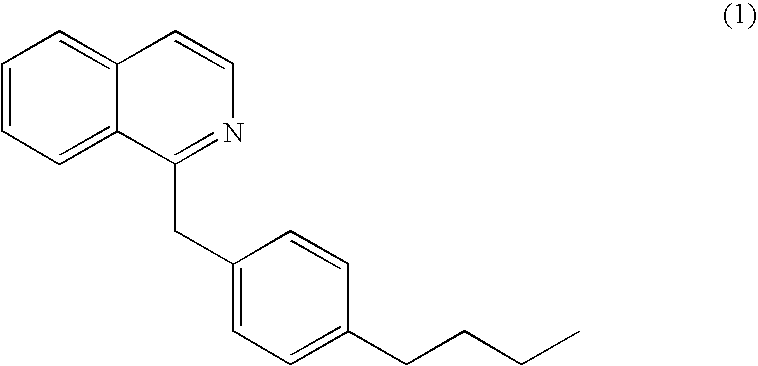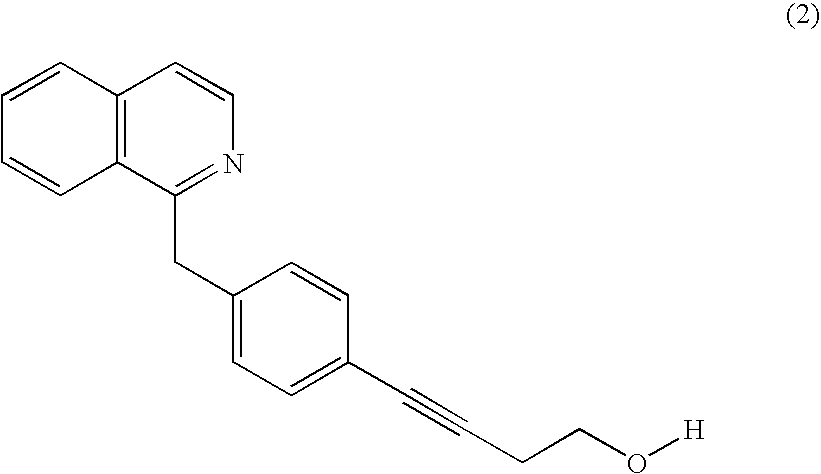Methods of screening for compounds that inhibit the biosynthesis of gpi in malaria parasites
a malaria parasite and biosynthesis technology, applied in the field of screening for compounds that inhibit the biosynthesis of gpi in malaria parasites, can solve the problems of toxic gpi and lethal symptoms
- Summary
- Abstract
- Description
- Claims
- Application Information
AI Technical Summary
Benefits of technology
Problems solved by technology
Method used
Image
Examples
example 1
P. falciparum GWT1 (PfGWT1)
[0178] (1) The nucleotide sequence of P. falciparum GWT1 (PfGWT1) (SEQ ID NO: 1) has been disclosed in the database of the P. falciparum genome (PlasmoDB database, http: / / plasmodb.org / ). The PfGWT1 gene was cloned by PCR using genomic DNA purified from P. falciparum (the 3D7 strain) as a template. The 5′ half and 3′ half of the PfGWT1 gene were prepared separately, and the two halves were assembled at an XbaI (TCTAGA) restriction enzyme site. Thus, the full-length PfGWT1 gene was prepared. In addition, restriction enzymes sites outside the coding region were included, thus allowing insertion into an expression vector.
[0179] (2) The 5′ half of the PfGWT1 gene was amplified by PCR using P. falciparum genomic DNA as a template and the primers pf152F (SEQ ID NO: 48) and pf136R (SEQ ID NO: 49). The 3′ half was amplified by the same procedure described above, using the primers pf137F (SEQ ID NO: 50) and pf151R (SEQ ID NO: 51). The DNA fragments amplified were ...
example 2
A Fully Synthetic PfGWT1 Gene
[0182] The adenine and thymine (AT) proportion is exceedingly high (80% or higher) in P. falciparum DNA, and thus routine biological techniques (PCR, E. coli-based gene engineering, expression systems for recombinant proteins, and so on) are often unavailable (Sato and Horii; Protein, Nucleic acid, and Enzyme Vol. 48, 149-155, 2003). Likewise, the AT content of PfGWT1 DNA was 80.41% including many consecutive A or T stretches. Thus, the gene was predicted to be difficult to replicate and express as a protein in yeast. Indeed, when native PfGWT1 ligated with a yeast overexpression vector was introduced into GWT1 disrupted yeast, the PfGWT1 did not rescue the lethal phenotype of the GWT1 disruptant at all. To reduce AT content, codons were replaced with synonymous codons without changing the original amino acid sequence.
[0183] The codon substitution was carried out based on the nucleotide sequence of P. falciparum GWT1 (SEQ ID NO: 1) disclosed in the P. ...
example 3
An Assay for Antimalarial Activity Using opfGWT1-Expressing Yeast
[0186] A screening system for compounds having antimalarial activity was constructed using opfGWT1-expressing yeast.
[0187] An expression cassette was constructed by inserting the S. cerevisiae GWT1 terminator, and the S. cerevisiae GAPDH promoter and multi-cloning site into the SacI-KpnI site of the single-copy vector pRS316. S. cerevisiae GWT1 and opfGWT1 were inserted into the multi-cloning site to prepare pGAP-ScGWT1 and pGAP-opfGWT1 plasmids, respectively. These plasmids were introduced into the GWT1 disruptant. Serial two-fold dilutions of compound (1) were prepared using YPAD to make the highest final concentration 50 μg / ml. A 50 μl aliquot of the diluted compound was added to each well of a 96-well plate. Overnight cultures of yeast cells comprising each plasmid were diluted 1000-fold and then a 50 μl aliquot of the dilution was added to each well. The plates were incubated at 30° C. for two days, and then cul...
PUM
| Property | Measurement | Unit |
|---|---|---|
| Fraction | aaaaa | aaaaa |
| Content | aaaaa | aaaaa |
Abstract
Description
Claims
Application Information
 Login to View More
Login to View More - R&D
- Intellectual Property
- Life Sciences
- Materials
- Tech Scout
- Unparalleled Data Quality
- Higher Quality Content
- 60% Fewer Hallucinations
Browse by: Latest US Patents, China's latest patents, Technical Efficacy Thesaurus, Application Domain, Technology Topic, Popular Technical Reports.
© 2025 PatSnap. All rights reserved.Legal|Privacy policy|Modern Slavery Act Transparency Statement|Sitemap|About US| Contact US: help@patsnap.com



